I seriously doubt anyone looking at a $25,000 projector is going to be focused on whether a projector has 2300 lumens or 2500, etc. I assume many of the high end shoppers are more about: Will it look great? Will it blow me away. (And perhaps: Will our friends be in awe?) And even: Will it go in my room?
No offense intended but many high end folks spend the bucks because they can afford the best, and don't think about the tech and other stuff that fascinates many of us. Some are spending the money for the experience and accept recommendations from "advisors" such as a local high end dealer that is highly regarded, or a friend who has already done the same.
Therefore this section is more about examples of how the projector will perform under different lighting! Of course it's near flawless in a fully darkened theater, but what happens when placed in less perfect rooms?
Since we didn't know we had the time for Eric to calibrate and do full measurements, all we did, in the measurement area, is my taking out my light meter, and doing a few very quick measurements. First of all, I've never found a really great way to measure ultra short throw projectors' brightness, and have said in the past, that we could be off by as much as 10%, due to the nature of UST projectors.
In just a few minutes I was able to conclude that at its brightest, the Sony just beats its claimed 2500 lumens, and that the typical modes used, such as Reference, all seemed to be in the 2000 lumen plus range.
In other words it's a very nicely bright home theater projector. For 1080p only we'd be saying 150" diagonal screen - no problem! But with 4K and HDR, the 120 inch diagonal screen size maximum that the optics are designed for, is very doable. I ran almost 100" diagonal downstairs when testing under a lot of ambient light. As discussed, in my near impossible room, with a UST screen, even 2500 lumens wasn't enough to offset a lot of sunlight, but it would be great for daytime sports and other moderate to bright viewing in almost any room environment better than mine. This closeup of a Caddyshack image shows you how it performs on a sports scene, under worst case ambient lighting:
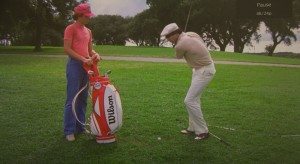
Closeup of Caddyshack scene on Sony VPL-VZ1000ES in an extremely bright room.
Here's a look at the room when that was taken:
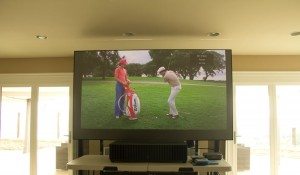
Same Caddyshack scene on Sony VPL-VZ1000ES in an extremely bright room, showing sunlight pouring in.
Here's one more image taken about the same time, this time, with an even better look at the room and how the sunlight affects it:
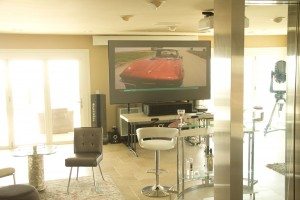
Star Trek on Sony VPL-VZ1000ES under worst case living room brightness scenario.
As you can see in the image above (although the same was true in all the images in this section so far) the room is bathed in sunlight. Worse, that sunlight is hitting the floor on either side of the projector. That is, the brightest part of the room is exactly where the ALR screen doesn't reject the lighting, as it would light from above. If this much sunlight was in the back of the room, the image on the screen would look dramatically better.
This next two pair of images - shot from back of room, and then a close up of part of the image, shows what happens on a not so bright day, but still full daytime:
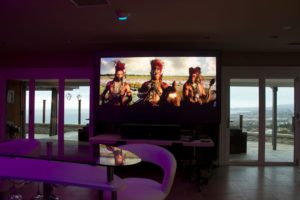
VZ1000ES handling a nicely bright room, but with no sunlight pouring in, 100" diagonal screen size. Image from Lucy.

Close-up of same image from Lucy.

Throwing additional ambient light in living room, no direct sunlight, VZ1000ES tackling a pretty dark scene.
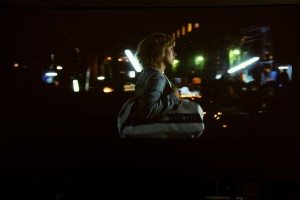
Closeup of the same night scene from Lucy, daytime, no sunlight, many room lights on.
Finally one more image, this time, however, taken at night with "lights on!"
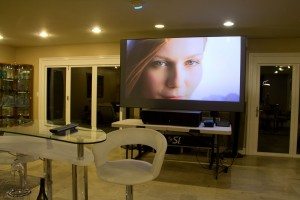
Combining the Sony VZ1000ES with the Screen Innovations Black Diamond UST ALR screen allows the projector to perform well at night, despite full brightness flood lights just a foot forward of the screen.
Upstairs we didn't exactly place the projector when Sony first brought it to me, so the maximum screen size was limited to about 112" diagonal. Once that projector (77 lbs) a 50+ pound Anthem AV receiver, plus all the other gear, was in and on my furniture, it was too heavy to pull the unit out an extra couple of inches to fill the full 120 inch maximum.
While in my theater I almost always watched at night with the room fully darkened, or in the daytime with my shutters mostly closed. This image below, shows the projector with the side window shutters open 50% (the left side of the window is blocked, the right side, is not.
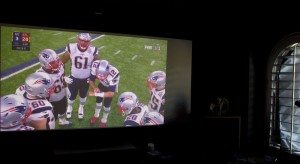
Ambient light from the side of my theater, has little impact on this sports image.

Close up sports scene in theater with ambient light present. No problem at all at 100" diagonal. Screen is not ideal for a UST projector. Using a Stewart Studiotek 130 screen.
Yet, as I have described, in a theater environment, the VPL-VZ1000ES did one great job on 4K HDR BT2020 content, and of course, it effortlessly did great on less challenging 4K or 1080 content.
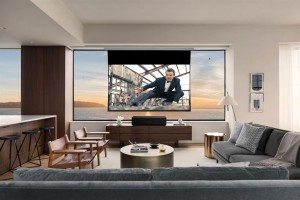
Sony provided brochure image of the VPL-VZ1000ES in a bright room environment. Just remember, the sky isn't near its brightest at sunset.
I seriously doubt anyone looking at a $25,000 projector is going to be focused on whether a projector has 2300 lumens or 2500, etc. I assume many of the high end shoppers are more about: Will it look great? Will it blow me away. (And perhaps: Will our friends be in awe?) And even: Will it go in my room?
No offense intended but many high end folks spend the bucks because they can afford the best, and don't think about the tech and other stuff that fascinates many of us. Some are spending the money for the experience and accept recommendations from "advisors" such as a local high end dealer that is highly regarded, or a friend who has already done the same.
Therefore this section is more about examples of how the projector will perform under different lighting! Of course it's near flawless in a fully darkened theater, but what happens when placed in less perfect rooms?
Since we didn't know we had the time for Eric to calibrate and do full measurements, all we did, in the measurement area, is my taking out my light meter, and doing a few very quick measurements. First of all, I've never found a really great way to measure ultra short throw projectors' brightness, and have said in the past, that we could be off by as much as 10%, due to the nature of UST projectors.
In just a few minutes I was able to conclude that at its brightest, the Sony just beats its claimed 2500 lumens, and that the typical modes used, such as Reference, all seemed to be in the 2000 lumen plus range.
In other words it's a very nicely bright home theater projector. For 1080p only we'd be saying 150" diagonal screen - no problem! But with 4K and HDR, the 120 inch diagonal screen size maximum that the optics are designed for, is very doable. I ran almost 100" diagonal downstairs when testing under a lot of ambient light. As discussed, in my near impossible room, with a UST screen, even 2500 lumens wasn't enough to offset a lot of sunlight, but it would be great for daytime sports and other moderate to bright viewing in almost any room environment better than mine. This closeup of a Caddyshack image shows you how it performs on a sports scene, under worst case ambient lighting:

Closeup of Caddyshack scene on Sony VPL-VZ1000ES in an extremely bright room.
Here's a look at the room when that was taken:

Same Caddyshack scene on Sony VPL-VZ1000ES in an extremely bright room, showing sunlight pouring in.
Here's one more image taken about the same time, this time, with an even better look at the room and how the sunlight affects it:

Star Trek on Sony VPL-VZ1000ES under worst case living room brightness scenario.
As you can see in the image above (although the same was true in all the images in this section so far) the room is bathed in sunlight. Worse, that sunlight is hitting the floor on either side of the projector. That is, the brightest part of the room is exactly where the ALR screen doesn't reject the lighting, as it would light from above. If this much sunlight was in the back of the room, the image on the screen would look dramatically better.
This next two pair of images - shot from back of room, and then a close up of part of the image, shows what happens on a not so bright day, but still full daytime:

VZ1000ES handling a nicely bright room, but with no sunlight pouring in, 100" diagonal screen size. Image from Lucy.

Close-up of same image from Lucy.

Throwing additional ambient light in living room, no direct sunlight, VZ1000ES tackling a pretty dark scene.

Closeup of the same night scene from Lucy, daytime, no sunlight, many room lights on.
Finally one more image, this time, however, taken at night with "lights on!"

Combining the Sony VZ1000ES with the Screen Innovations Black Diamond UST ALR screen allows the projector to perform well at night, despite full brightness flood lights just a foot forward of the screen.
Upstairs we didn't exactly place the projector when Sony first brought it to me, so the maximum screen size was limited to about 112" diagonal. Once that projector (77 lbs) a 50+ pound Anthem AV receiver, plus all the other gear, was in and on my furniture, it was too heavy to pull the unit out an extra couple of inches to fill the full 120 inch maximum.
While in my theater I almost always watched at night with the room fully darkened, or in the daytime with my shutters mostly closed. This image below, shows the projector with the side window shutters open 50% (the left side of the window is blocked, the right side, is not.

Ambient light from the side of my theater, has little impact on this sports image.

Close up sports scene in theater with ambient light present. No problem at all at 100" diagonal. Screen is not ideal for a UST projector. Using a Stewart Studiotek 130 screen.
Yet, as I have described, in a theater environment, the VPL-VZ1000ES did one great job on 4K HDR BT2020 content, and of course, it effortlessly did great on less challenging 4K or 1080 content.

Sony provided brochure image of the VPL-VZ1000ES in a bright room environment. Just remember, the sky isn't near its brightest at sunset.












